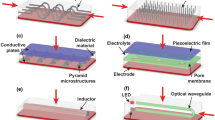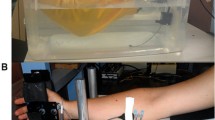Abstract
These experiments were designed to test the idea that, in a forearm position-matching task, it is the difference in afferent signals coming from the antagonist muscles of the forearm that determines the perceived position of the arm. In one experiment, flexor and then extensor muscles of the reference arm were conditioned by isometric voluntary contractions while the arm was held at the test angle, approximately 45° from the horizontal. At the same time, indicator arm flexor muscles were contracted while the arm was flexed, or extensors were contracted while it was extended. After an indicator flexor contraction, during matching, subjects made large errors in the direction of flexion, by 9.3° relative to the reference arm and after an indicator extensor contraction by 7.4° in the direction of extension. In the second experiment, with reference muscles conditioned as before, slack was introduced in indicator muscles by a combination of muscle contraction and stretch. This was expected to lower levels of afferent activity in indicator muscles. The subsequent matching experiment yielded much smaller errors than before, 1.4° in the direction of flexion. In both experiments, signal levels coming from the reference arm remained the same and what changed was the level of indicator signal. The fact that matching errors were small when slack was introduced in indicator muscles supported the view that the signal coming from reference muscles was also small. It was concluded that the brain is concerned with the signal difference from the antagonist pair of each arm and with the total signal difference between the two arms.



Similar content being viewed by others
References
Allen TJ, Proske U (2006) Effect of muscle fatigue on the sense of limb position and movement. Exp Brain Res 170:30–38
Allen TJ, Ansems GE, Proske U (2007) Effects of muscle conditioning on position sense at the human forearm during loading or fatigue of elbow flexors and the role of the sense of effort. J Physiol 580(2):423–434
Clark FJ, Burgess RC, Chapin JW, Lipscomb WT (1985) Role of intramuscular receptors in the awareness of limb position. J Neurophysiol 54(6):1529–1540
Gilhodes JC, Roll JP, Tardy-Gervet MF (1986) Perceptual and motor effects of agonist-antagonist muscle vibration in man. Exp Brain Res 61(2):395–402
Goodwin GM, McCloskey DI, Matthews PB (1972) The contribution of muscle afferents to kinaesthesia shown by vibration induced illusions of movement and by the effects of paralysing joint afferents. Brain 95(4):705–748
Gregory JE, Morgan DL, Proske U (1988) Chapter 11 responses of muscle spindles depend on their history of activation and movement. Prog Brain Res 74:85–90
Gregory JE, Morgan DL, Proske U (1991) Two kinds of resting discharge in cat muscle spindles. J Neurophysiol 66(2):602–612
Gregory JE, Wise AK, Wood SA, Prochazka A, Proske U (1998) Muscle history, fusimotor activity and the human stretch reflex. J Physiol 513(Pt 3):927–934
Hakuta N, Izumizaki M, Kigawa K, Murai N, Atsumi T, Homma I (2014) Proprioceptive illusions created by vibration of one arm are altered by vibrating the other arm. Exp Brain Res 232(7):2197–2206
Hill DK (1968) Tension due to interaction between the sliding filaments in resting striated muscle. The effect of stimulation. J Physiol 199(3):637–684
Izumizaki M, Tsuge M, Akai L, Proske U, Homma I (2010) The illusion of changed position and movement from vibrating one arm is altered by vision or movement of the other arm. J Physiol 588(15):2789–2800
Longo MR, Haggard P (2010) An implicit body representation underlying human position sense. PNAS 107(26):11727–11732
Matthews PBC (1988) Proprioceptors and their contribution to somatosensory mapping: complex messages require complex processing. Can J Physiol Pharmcol 66:430–438
Morgan DL, Prochazka A, Proske U (1984) The after-effects of stretch and fusimotor stimulation on the responses of primary endings of cat muscle spindles. J Physiol 356:465–477
Proske U (2015) The role of muscle proprioceptors in human limb position sense: a hypothesis. J Anat 227(2). doi:10.1111/joa.12289
Proske U, Tsay A, Allen T (2014) Muscle thixotropy as a tool in the study of proprioception. Exp Brain Res 232(11):3397–3412
Tsay A, Savage G, Allen TJ, Proske U (2014) Limb position sense, proprioceptive drift and muscle thixotropy at the human elbow joint. J Physiol 592(Pt 12):2679–2694
White O, Proske U (2009) Illusions of forearm displacement during vibration of elbow muscles in humans. Exp Brain Res 192(1):113–120
Author information
Authors and Affiliations
Corresponding author
Rights and permissions
About this article
Cite this article
Tsay, A., Allen, T.J. & Proske, U. Position sense at the human forearm after conditioning elbow muscles with isometric contractions. Exp Brain Res 233, 2635–2643 (2015). https://doi.org/10.1007/s00221-015-4334-5
Received:
Accepted:
Published:
Issue Date:
DOI: https://doi.org/10.1007/s00221-015-4334-5




